
India, a nation of rich cultural diversity and historical significance, has its share of notorious criminals whose deeds have left a significant mark on society. These individuals often became symbols of lawlessness and have captured public attention due to their heinous acts. This article delves into ten of the most infamous criminals in India, exploring their backgrounds, crimes, and the impact they had on society.
1. Dawood Ibrahim
Dawood Ibrahim is perhaps the most infamous criminal in India, often regarded as the country’s most wanted fugitive. Born in 1955 in Maharashtra, Ibrahim is the mastermind behind the D-Company, a criminal syndicate involved in drug trafficking, extortion, and terrorism. He gained global notoriety for his role in the 1993 Bombay bombings, which killed over 250 people and injured more than 700. His extensive network spans several countries, including Pakistan, where he is believed to reside. Ibrahim’s life of crime has made him a central figure in discussions about organized crime in India and its links to terrorism.
2. Veerappan
Veerappan was a notorious bandit and poacher who operated in the forests of Karnataka and Tamil Nadu. Born in 1952, he became infamous for his audacious crimes, including smuggling ivory and sandalwood, kidnapping, and murder. His criminal exploits lasted for nearly two decades, during which he eluded law enforcement through a combination of local support and knowledge of the terrain. In 2004, after a prolonged operation by Indian authorities, Veerappan was killed in a police encounter. His life and crimes have been the subject of numerous books and films, highlighting the complexities of his character and the socio-economic factors that contributed to his rise.
3. Abu Salem
Abu Salem, an associate of Dawood Ibrahim, is another significant figure in India’s criminal landscape. Born in 1969, he became a key player in the underworld, involved in extortion, contract killings, and the smuggling of arms and narcotics. Salem was implicated in the 1993 Bombay bombings and was subsequently arrested in Portugal in 2002. His extradition to India sparked public interest, as he was one of the first high-profile criminals to face trial in the country after his arrest. He has since been convicted on multiple charges, and his story illustrates the intricate ties between crime and politics in India.
4. Phoolan Devi
Phoolan Devi, also known as the “Bandit Queen,” became a symbol of rebellion against social injustices in India. Born in 1963 in a low-caste family, she faced numerous hardships, including abuse and exploitation. Her life took a dramatic turn when she joined a bandit gang, ultimately leading her to become a notorious outlaw. Devi was involved in several criminal activities, including kidnappings and killings. However, her legacy is complicated; she was later pardoned and entered politics, becoming a member of parliament. Her life story has been depicted in various films and books, highlighting the intersection of crime, gender, and social issues in India.
5. Nirbhaya Case Criminals
The Nirbhaya case, involving the brutal gang rape and murder of a young woman in Delhi in December 2012, shocked the nation and ignited widespread protests. The case highlighted the pervasive issue of violence against women in India. The four men convicted in this heinous crime became infamous not just for their actions but also for the discussions they sparked regarding women’s safety and legal reforms. The public outrage following the case led to significant changes in laws related to sexual violence, showcasing the potential for criminal cases to influence societal change.
6. Ajmal Kasab
Ajmal Kasab, a member of the terrorist group Lashkar-e-Taiba, became infamous as one of the perpetrators of the 2008 Mumbai attacks. Born in Pakistan, he was one of the ten terrorists who carried out a series of coordinated attacks across Mumbai, resulting in the deaths of 166 people. Kasab was captured alive during the attacks, and his subsequent trial provided a wealth of information about the planning and execution of the attacks. His execution in 2012 brought a sense of closure to many victims’ families but also sparked debates about the death penalty and its effectiveness as a deterrent to terrorism.
7. Santosh Ghangrekar
Santosh Ghangrekar, a lesser-known yet equally notorious figure, was involved in a series of heinous crimes, including a spate of rapes and murders in Maharashtra. His methods were particularly brutal, and he preyed on vulnerable women. Ghangrekar’s arrest in 2013 brought relief to many, but it also highlighted the ongoing issue of violence against women in India. His case sparked discussions about the need for better law enforcement and preventive measures to protect women in society.
8. Rajendra Sadashiv Nikalje (Chhota Rajan)
Chhota Rajan, born in 1960, is a notorious gangster and former associate of Dawood Ibrahim. After a falling out with Ibrahim, he established his own crime syndicate. Nikalje was involved in extortion, drug trafficking, and several high-profile murders. He was arrested in 2015 after being on the run for years. His life reflects the power struggles within the underworld and the impact of organized crime on the political landscape in India.
9. Babu Bajrangi
Babu Bajrangi, a former member of the Vishwa Hindu Parishad (VHP), gained notoriety for his involvement in the 2002 Gujarat riots. He was convicted of orchestrating violence against the Muslim community during this tumultuous period, leading to the deaths of many innocents. His actions and subsequent conviction highlight the intersection of politics, religion, and crime in India, as well as the ongoing communal tensions in the country.
10. Saddam Hussain (Saddam Bhai)
Saddam Hussain, also known as Saddam Bhai, is an infamous gangster known for his involvement in organized crime in Mumbai. His activities include extortion, drug trafficking, and murder. He became a significant figure in the Mumbai underworld during the 1990s and was linked to various high-profile criminal activities. His story sheds light on the ongoing battle between law enforcement and organized crime in urban India.
Conclusion
The criminals discussed above represent just a fraction of the complex tapestry of crime in India. Each of these individuals has left a lasting impact on society, sparking conversations about justice, law enforcement, and the underlying socio-economic factors that contribute to crime. While some have been brought to justice, others continue to evade capture, reminding us of the persistent challenges in combating organized crime and ensuring public safety.
As India progresses, it is crucial to understand the stories of these criminals not just as cautionary tales, but as reflections of deeper societal issues that need to be addressed. Through a combination of law enforcement, community engagement, and socio-economic development, the hope is to create a safer and more just society for all.




























